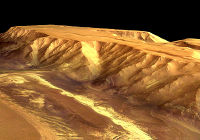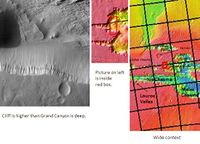Difference between revisions of "Candor Chasma"
(added info and ref) |
(tried to add info and ref) |
||
| Line 22: | Line 22: | ||
[[Image:Candor1.jpg|thumb|200px|left|A rendering of Candor Chasma using data from the The High Resolution Stereo Camera (HRSC) on board [[ESA]]'s [[Mars Express]].]] | [[Image:Candor1.jpg|thumb|200px|left|A rendering of Candor Chasma using data from the The High Resolution Stereo Camera (HRSC) on board [[ESA]]'s [[Mars Express]].]] | ||
| + | |||
| + | ===References:=== | ||
| + | <references/> | ||
==External Links== | ==External Links== | ||
Revision as of 10:11, 19 February 2018
Candor Chasma is one of the largest canyons in the Valles Marineris canyon system. ==Origin of Name== Coprates is the name of a classical albedo features on Mars located at 15° S and 60° W (300 E) on Mars. It is named after the Coprates River, an ancient name for the Dez River in modern Iran which empties into the Shatt al-Arab near its Persian Gulf estuary. The name was approved by the International Astronomical Union (IAU) in 1958.[1][2]
Chandor Chasma was made famous in the novel "Red Mars" by Kim Stanley Robinson as the location of the first future Mars base after the first manned mission in 2026. The idea of "Underhill", the first established settlement, originates from the Hillside settlement as designed by the Mars Foundation's co-founder, Bruce Mackenzie.

References:
- ↑ USGS Gazetteer of Planetary Nomenclature. Mars. http://planetarynames.wr.usgs.gov/.
- ↑ Template:Cite web
External Links
| Concepts: | Greenhouse · Settlements · Locations · General |
| Hazards: | Space Weather · Climate · General |
| Technology: | Hi-Tech · Lo-Tech · Energy · Spaceflight science · Communication · General |
| Human Considerations: | Economics · Health · Governance · Trade · Law · Social |









